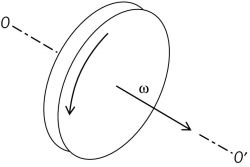velocity
Velocity
The time rate of change of position of a body in a particular direction. Linear velocity is velocity along a straight line, and its magnitude is commonly measured in such units as meters per second (m/s), feet per second (ft/s), and miles per hour (mi/h). Since both a magnitude and a direction are implied in a measurement of velocity, velocity is a directed or vector quantity, and to specify a velocity completely, the direction must always be given. The magnitude only is called the speed. See Speed
A body need not move in a straight line path to possess linear velocity. When a body is constrained to move along a curved path, it possesses at any point an instantaneous linear velocity in the direction of the tangent to the curve at that point. The average value of the linear velocity is defined as the ratio of the displacement to the elapsed time interval during which the displacement took place.
The representation of angular velocity ω as a vector is shown in the illustration. The vector is taken along the axis of spin. Its length is proportional to the angular speed and its direction is that in which a right-hand screw would move. If a body rotates simultaneously about two or more rectangular axes, the resultant angular velocity is the vector sum of the individual angular velocities.
velocity
[və′läs·əd·ē]velocity
Velocity
in mechanics, a kinematic quantity characterizing the motion of a point. Strictly speaking, velocity is a vector quantity and thus has both a magnitude and a direction. The magnitude, a scalar quantity, is known as speed. The term “velocity,” however, is sometimes loosely used in the sense of “speed.”
For a point in uniform motion, its speed v is equal to the ratio of the distance s traversed to the time t in which this distance is traveled—that is, v = s/t. In the general case, the instantaneous speed of a point is v = ds/dt, and the instantaneous velocity is v = dr/dt, where r is the radius vector of the point. The velocity vector is directed along the tangent to the point’s trajectory. If the motion of the point is defined by equations that express the dependence of the point’s Cartesian coordinates x, y, and z on the time t, then
![]()
where vx = dx/dt, vy= dy/dt, and vz = dz/dt. The cosines of the angles formed by the velocity vector and the coordinate axes are equal to vx/vx vy/vz and vz/v, respectively.
